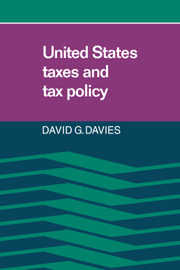Book contents
- Frontmatter
- Contents
- Preface
- 1 Economic foundations of U.S. tax policy
- 2 The individual income tax
- 3 Economic effects of individual income taxes and inflation
- 4 Expenditure versus income taxation
- 5 The taxation of capital gains
- 6 The corporation income tax
- 7 The corporation income tax and inflation
- 8 Social security payroll taxes
- 9 The value added tax
- 10 The sales tax
- 11 State taxes
- 12 Local government taxes
- 13 The distribution of tax burdens
- 14 Status of U.S. taxes and policy
- Appendix
- References
- Index
- Frontmatter
- Contents
- Preface
- 1 Economic foundations of U.S. tax policy
- 2 The individual income tax
- 3 Economic effects of individual income taxes and inflation
- 4 Expenditure versus income taxation
- 5 The taxation of capital gains
- 6 The corporation income tax
- 7 The corporation income tax and inflation
- 8 Social security payroll taxes
- 9 The value added tax
- 10 The sales tax
- 11 State taxes
- 12 Local government taxes
- 13 The distribution of tax burdens
- 14 Status of U.S. taxes and policy
- Appendix
- References
- Index
Summary
In addition to the cross-sectional analysis cited in the text, Feldstein and Slemrod (1978c: 134) have used time series analysis to study the lock-in effect and its impact on government revenue. They compared the two years before the 1969 Act that increased taxes with the two years most recently available. Realized gains increased by 18 percent during this period for individuals with income less than $100,000. Investors with incomes between $100,000 and $500,000, and those in excess of $500,000 whose tax rates were more substantially affected by the 1969 law, realized gains decreased by 12 percent and 35 percent, respectively. The time series data support the idea of sensitivity developed in their massive NBER cross-sectional study (Feldstein 1978b:508).
Feldstein and Slemrod (1978c: 134) conclude that under high rates of taxation unrealized gains remain locked into portfolios. Lowering tax rates would unlock them and permit a substantially higher volume of trading in assets, which would not only make investors better off but also make Treasury richer in the process, at least in the short run (Feldstein 1979b:55).
Otto Eckstein, the president of Data Resources, Inc., agrees with the NBER finding. He notes that investors in the top tax bracket “don't sell stock and don't take their capital gains” (Zucker 1978:24). Researchers at Data Resources, who analyzed a series of tax proposals, estimated that if the tax on capital gains were totally eliminated, federal tax receipts would decline by $5.1 billion in 1978 but then rise by approximately $38 billion during the next five years (“Footnotes to the Above” 1978:20).
- Type
- Chapter
- Information
- United States Taxes and Tax Policy , pp. 288 - 292Publisher: Cambridge University PressPrint publication year: 1986



